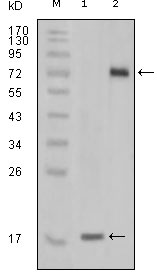NOK Monoclonal Antibody
- Catalog No.:YM0479
- Applications:WB;IHC;IF;ELISA
- Reactivity:Human
- Target:
- STYK1/NOK
- Gene Name:
- STYK1
- Protein Name:
- Tyrosine-protein kinase STYK1
- Human Gene Id:
- 55359
- Human Swiss Prot No:
- Q6J9G0
- Mouse Swiss Prot No:
- Q6J9G1
- Immunogen:
- Purified recombinant fragment of NOK expressed in E. Coli.
- Specificity:
- NOK Monoclonal Antibody detects endogenous levels of NOK protein.
- Formulation:
- Liquid in PBS containing 50% glycerol, 0.5% BSA and 0.02% sodium azide.
- Source:
- Monoclonal, Mouse
- Dilution:
- WB 1:500 - 1:2000. IHC 1:200 - 1:1000. ELISA: 1:10000.. IF 1:50-200
- Purification:
- Affinity purification
- Storage Stability:
- -15°C to -25°C/1 year(Do not lower than -25°C)
- Other Name:
- STYK1;NOK;Tyrosine-protein kinase STYK1;Novel oncogene with kinase domain;Protein PK-unique;Serine/threonine/tyrosine kinase 1
- Molecular Weight(Da):
- 48kD
- References:
- 1. Liu L, Yu XZ and Li TS, et al. Mol Biol Rep. 2003, Jun, 30(2):91-6.
2. Moriai R. , Kobayashi D.and Amachika T. , et al. Mol Biol Rep. 2007, Apr, 6.
- Background:
- Receptor protein tyrosine kinases, like STYK1, play important roles in diverse cellular and developmental processes, such as cell proliferation, differentiation, and survival (Liu et al., 2004 [PubMed 15150103]).[supplied by OMIM, Mar 2008],
- Function:
- catalytic activity:ATP + a [protein]-L-tyrosine = ADP + a [protein]-L-tyrosine phosphate.,function:Probable tyrosine protein-kinase, which has strong transforming capabilities on a variety of cell lines. When overexpressed, it can also induce tumor cell invasion as well as metastasis in distant organs. May act by activating both MAP kinase and phosphatidylinositol 3'-kinases (PI3K) pathways.,similarity:Belongs to the protein kinase superfamily. Tyr protein kinase family.,similarity:Contains 1 protein kinase domain.,tissue specificity:Widely expressed. Highly expressed in brain, placenta and prostate. Expressed in tumor cells such as hepatoma cells LO2, cervix carcinoma cells HeLa, ovary cancer cells Ho8910 and chronic myelogenous leukemia cells K562, but not in other tumor cells such as epidermoid carcinoma (A431). Undetectable in most normal lung tissues, widely expressed in lung cancer
- Subcellular Location:
- Membrane ; Single-pass membrane protein .
- Expression:
- Widely expressed. Highly expressed in brain, placenta and prostate. Expressed in tumor cells such as hepatoma cells L-02, cervix carcinoma cells HeLa, ovary cancer cells Ho8910 and chronic myelogenous leukemia cells K-562, but not in other tumor cells such as epidermoid carcinoma (A-431). Undetectable in most normal lung tissues, widely expressed in lung cancers.
- June 19-2018
- WESTERN IMMUNOBLOTTING PROTOCOL
- June 19-2018
- IMMUNOHISTOCHEMISTRY-PARAFFIN PROTOCOL
- June 19-2018
- IMMUNOFLUORESCENCE PROTOCOL
- September 08-2020
- FLOW-CYTOMEYRT-PROTOCOL
- May 20-2022
- Cell-Based ELISA│解您多样本WB检测之困扰
- July 13-2018
- CELL-BASED-ELISA-PROTOCOL-FOR-ACETYL-PROTEIN
- July 13-2018
- CELL-BASED-ELISA-PROTOCOL-FOR-PHOSPHO-PROTEIN
- July 13-2018
- Antibody-FAQs
- Products Images

- Western Blot analysis using NOK Monoclonal Antibody against truncated STYK1 recombinant protein(1) and STYK1 (aa47-422)-hIgGFc transfected CHO-K1 cell lysate (2).

- Immunohistochemistry analysis of paraffin-embedded human ovary carcinoma (A), normal cerebrum tissues (B), breast infiltrating carcinoma (C) and breast infiltrating carcinoma (D), showing cytoplasmic localization with DAB staining using NOK Monoclonal Ant



